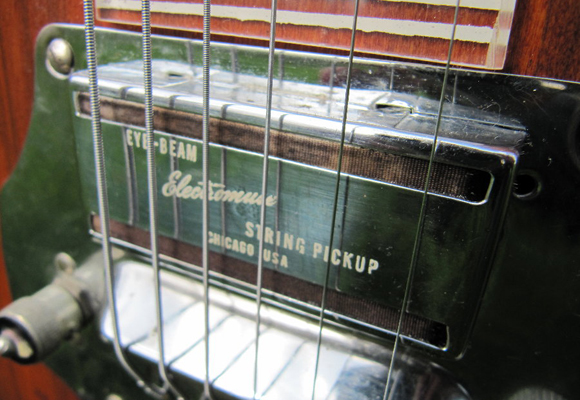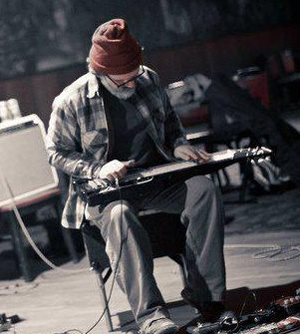
I don’t remember what drove me to my first lap steel. Maybe I needed a new sound for a song my band was working on, or perhaps I just felt like my guitar playing was in a rut. Whatever the reason, once I discovered it I was instantly hooked.
I started with an old Electromuse (it looked like a boat paddle), and then had to figure out what to do with it, and so I commenced the seemingly endless quest for the right tuning, picks, bar, and tone. Now, this was before we all had the Interwebs at our fingertips (back when I’d visit the library once a week to review the three emails I’d acquired since last login), so how-to videos via youtube simply were not an option. I was left to my own devices.

Electromuse Lap Steel Guitar Pickup
I plunked away on my steel, but I was missing something. My sound was thin, and noisy, and out of tune…nothing like what I was hearing in my head. I chipped away at it without much luck, until I met Spider Webb Welten.
Willbern “Spider Webb” Welten owned a music store in Sparta, IL (also noteworthy as the film-shooting locale for some scenes from the original movie version of In The Heat Of The Night). Welton’s was a small, quirky store that shared its quarters with a wig shop/hair salon run by his wife, and it featured a few glass counters, about twelve guitars wrapped in plastic (for that cozy, backwoods, Invasion of the Body Snatchers ambiance), and some miscellaneous cases which, I would soon find out, housed lap steels and pedal steels.
Upon my first visit I took in the air, tainted with the chemical aroma of hair product, as a skinny, elderly man came out from the back and asked how he could help me. As soon as I told him I was looking for a set of steel strings, the old man perked up. ” C6TH, E9TH or both?” he inquired, and I could already tell I was in way over my head. “Uh…it’s for a lap steel?” The old man frowned and corrected me, “it’s not a ‘lap steel,’ it’s a straight steel, son” and he walked behind the counter and pulled out a pack of 6-string “straight steel” strings. Then he took out a card and scratched down A/C#/E/A/C#/E, with the words ” Top A Tuning ” underneath. As I paid for my strings, I asked if he had any other tips. In the course of the next hour, Webb pulled out three lap steels (straight steels), three pedal steels, an assortment of finger picks, and a magazine that had his picture on the cover. I realized that this was the guy, and I had happened to find him in middle-of-nowhere-southern-Illinois by complete chance.
Following are some of the tips that I learned from Spider Webb that day. These small nuggets of information that the steel guru shared have been invaluable, and I hope they will also help you on your journey to steel enlightenmen:
- Get some heavier strings. Most steels come with fairly light strings, but thin strings equal thin tone, and this is especially true for the lap steel (which is the name I still call it by…sorry Webb). I typically use a custom gauge that consists of .056-.016, and I feel they produce a nice, fat tone, whether played clean or overdriven.
- Use two metal finger picks and a plastic thumb pick. This is the key to speed and articulation, and will help you cut through a band better than simply using your fingers. I prefer a medium Pro-Pic that is heavy enough that I can barely bend it, and a heavy, large National thumb pick. I often use a lighter, blue Herco pick, which I also use for the banjo and the pedal steel, because I’m too lazy to carry multiple thumb picks with me, but the heavy Nationals give me a much fuller tone. Fingers without picks can give you a really great tone as well, so you may experiment both ways.
- Keep your fingers on the strings behind the bar. This was a huge eye-opener for me, as it allowed me to get a truly defined tone without any noise. It also helps to keep the bar straight and accurate for better intonation.
- Play on the line. This takes a little time to get used to, but you always want to keep your bar directly over the fret marker. Playing in the space will cause you to be flat.
- It’s not fine china, so don’t be afraid to use some pressure and push down on the strings with the bar. You will get a much better tone this way.
- Use a volume pedal. Starting with the pedal about 20-30% engaged will give you plenty of room to add sustain to notes when needed.
- Use vibrato the way a singer would. Play the note clear and solid, and then add a slow vibrato by rolling and moving the bar back and forth. This is one of the more difficult techniques to learn, and it takes some time to accomplish.
Here are a couple of videos of me playing the Airline Lap Steel Guitar, available from www.eastwoodguitars.com for only $349:
1) Hawaiian Tone
2) Kick Butt Blues Tone:
I’ve owned two of Eastwood’s Airline lap steels, and I believe they are the best steel on the market for the money. The Airline has plenty of string height at the nut, and a bit wider string spacing than other steels in the same price range. The body has plenty of mass and weight, giving the steel a great tone, both clean and driven. Add a bit of delay and fuzz for an over the top tone, or try some modulation effects or a POG for a cool organ effect.
Written by: Dave Anderson


An important caveat regarding string thickness:
You needn’t get thicker strings if you are using a tuning appropriate to the string gauge. Sounds to me that when you got your first steel it was likely set up for C6 tuning — still the most popular six string lap steel tuning. When tuned up properly you would get tone a-plenty with those strings.
Also of note to beginners who buy vintage is that those old steels sometimes have pups (pickups) with weakened magnets. These can be recharged or replaced (altho in my opinion I would rather recharge so that the vintage sound is preserved).
Cool article. I would love to see more on lap steel.
Thanks for the post Dave. I bought an original 60s airline lap steel wanting to try it out for slide stuff as the guitars I usually play have low action that makes slide difficult to execute properly. I figured if I was going to be bringing another guitar anyway…Love the original humbucker in my 60s lapsteel, it is awesome.
Anyway, your tips ring true. Intonation generally has been the biggest challenge for me, particular playing in situation where the monitoring is sub optimal. I have done gigs where I could not hear myself, and let me tell you, that is a huge problem when playing a steel.
I have been wanting to learn the C7 tuning better, or another tuning, I have been playing in open E maj/min for a while, but it seem limiting. Maybe it is time to seek out some C7 lessons.
Hello,
I’m trying to restore a Kalamazoo lap steel(straight steel) guitar.I can furnish more information as needed. Where can I find the correct components? i.e. the pickup assembly, etc. Any information is appreciated.
Thank you,
Mike W
Dear Sir,
The Airline Guitar, featured Video : Eastwood Classic 12, Wendell Ferguson, seems to be possessing a tonal quality ensuing the vibes of the heart continuously. Nicely built with bright pickups. I wish to know the airline pickups used in this guitar in order to buy them if appeared to be reasonable in price. Will you favour me with a word in this regard. Thanks!
Love your page…. keep it up….. !!!!!
I have played many vintage Hawaiian Lap steels over the years and my experience finds of the vintage ones, the best sound and playability have been the old Rickenbackers and the old Supro’s. Both have very interesting pick ups. Visually the are many interesting lesser known brands. The old Nationals with the art deco styling are nice too. This new Eastman/Airline sounds good.
Spider was a good friend of mine, still miss him a lot. He had the sweetest sound of them all.
Excellent blog! Do you have any hints for aspiring writers?
I’m planning to start my own website soon but I’m
a little lost on everything. Would you propose starting with a free
platform like WordPress or go for a paid option? There are so many options
out there that I’m completely confused .. Any tips? Many thanks!
Asher Electro Hawaiian Junior Lap Steel is a great cross over instrument for guitar players, and played by some of the pros in the business. You can get one here for $675 free shipping.
http://www.asherguitars.com
With the rare, rare exception (59Gibsonultratone) all vintage lap or straight steels use single coil pickups, despite the shape of the pickup cover.
Would .056 – .016 custom strings. Be a good gauge to start with for a beginner who wants
Good sound on my 6 string lap steel. Using basic c6. Tuning to start with ? I’m leaning towards the air line lap steel.
I think .056 is a bit heavy for C6. I admit I’m a bit of a beginner myself.
Here’s the gauge I use: (low to high)
C .036
E .030
G .026
A .022
C .017
E .015
Anyone heard of a h.s. anderson lap steel guitar?
Remarkable! Its truly amazing piece of writing, I have got
much clear idea about from this post.